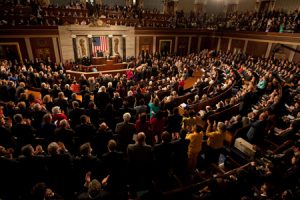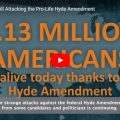
Joint Session of the United States Congress
In 1976, just 3 years after the U.S. Supreme Court’s Roe v. Wade abortion decision, Congress attached a rider called “the Hyde Amendment” to its annual funding appropriation legislation.
The Hyde Amendment is named after Congressman Hyde of Illinois, and it has appeared in some form or fashion on every annual appropriation bill Congress has passed since 1976.
Although the specific wording has varied from year to year, generally speaking, the Hyde Amendment prevents federal funds from being used to pay for abortions, except in certain situations, such as cases of rape, incest, or to save the life of the mother.
The Hyde Amendment has long been viewed as a delicate compromise between pro-life advocates and abortion advocates. For example, Arkansas’ constitution prohibits public funding of abortion. In the spring of 1996, following a lengthy legal battle, the U.S. Supreme Court decided Arkansas’ policy against public funding of abortion was constitutional, but also decided that under the Hyde Amendment Arkansas still had to use Medicaid funds to pay for abortions in cases rape, incest, or to save the life of the mother, if the mother qualified for Medicaid (Dalton v. Family Planning Services, 1996).
In other words, while the Hyde Amendment does not prohibit all federal funding of abortion, is does prohibit it most of the time. But lately there seems to be an attack brewing against the Hyde Amendment.
For example, the Democratic National Committee put language in the 2016 Democratic Platform saying,
We believe unequivocally, like the majority of Americans, that every woman should have access to quality reproductive health care services, including safe and legal abortion—regardless of where she lives, how much money she makes, or how she is insured. We believe that reproductive health is core to women’s, men’s, and young people’s health and wellbeing. We will continue to stand up to Republican efforts to defund Planned Parenthood health centers, which provide critical health services to millions of people. We will continue to oppose—and seek to overturn—federal and state laws and policies that impede a woman’s access to abortion, including by repealing the Hyde Amendment.
It’s important to point out that recent public opinion polling shows most Americans think abortion ought to be illegal in some or all cases, and the majority (62%) oppose paying for abortions with taxpayer dollars.
That aside, the 2016 Democratic Platform differs from the party’s past platforms, which repeatedly called for making abortion “safe, legal, and rare.”
At a recent political gathering, Planned Parenthood President Cecile Richards called for the repeal of the Hyde Amendment, saying, “[A]bortion is a right, and it’s no good to have a right if you can’t exercise it. And that means we have to repeal the Hyde Amendment.”
It’s baffling why there is seemingly a sudden interest in repealing the Hyde Amendment. This is a bipartisan budget provision that’s been on the books 40 years, and all it does is prevent Americans from being forced to subsidize abortions with their tax dollars.
Even the Obama Administration, whose track record on abortion is by no means pro-life, has not come out in favor of repealing the Hyde Amendment. In fact, President Obama signed an executive order in 2010 applying the Hyde Amendment to the Affordable Care Act to address some of the concerns about public funding of abortion under Obamacare.
Abortion advocates have often repeated the mantra, “If you don’t like abortion, don’t have one.” Without the Hyde Amendment, however, even if you don’t like abortion and don’t have an abortion, you could still be forced to pay for an abortion with your taxes.



